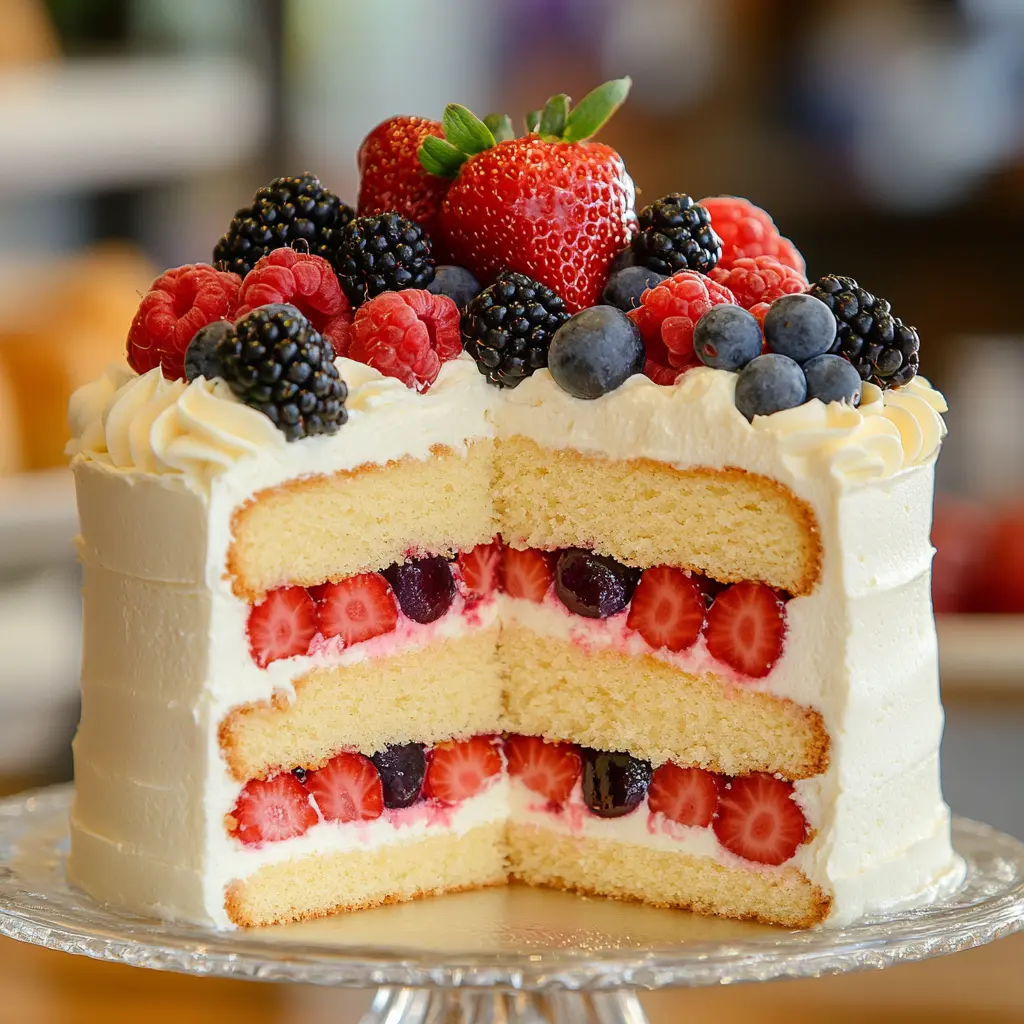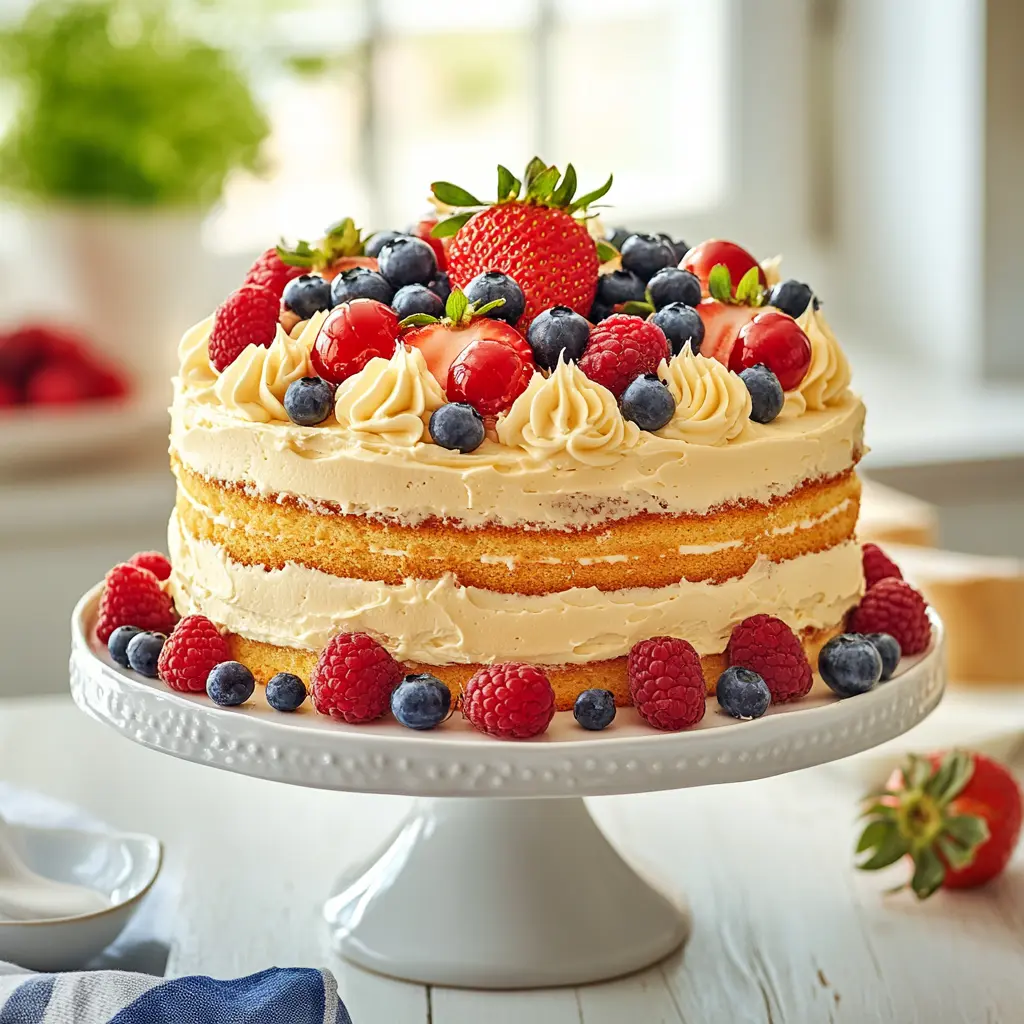Chantilly cake is more than just a dessert—it’s a masterpiece of flavor, texture, and elegance. From its velvety whipped Chantilly cream to the soft, fluffy cake base, every bite is a perfect balance of sweetness and freshness. But what exactly makes this cake so special?
In this article, we’ll dive deep into the origins, ingredients, and sensory appeal of Chantilly cake. You’ll learn why this cake has captivated dessert lovers worldwide, how it’s made, and even the best occasions to serve it. Whether you’ve had it before or you’re just curious, get ready to discover why this cake is a true showstopper.
Part 1: Introduction to Chantilly Cake
The Origins of Chantilly Cake
Historical Background
The story of Chantilly cake isn’t as straightforward as you might think. While some believe it has roots in France, others claim its origins trace back to Southern U.S. bakeries. The name itself is inspired by Chantilly cream, a delicately sweetened whipped cream that originated in Chantilly, France. However, the cake we adore today is a modern creation, featuring layers of sponge cake, fresh fruit, and rich cream.
Evolution Over Time
Originally, Chantilly cake was a simple sponge cake layered with Chantilly cream and berries. Over the years, bakers have put their own spin on it, incorporating different cake bases, mascarpone cheese, and even nut-based variations. Today, one of the most popular versions is the Berry Chantilly Cake, a favorite among Whole Foods shoppers.
What Makes Chantilly Cake Unique?
Key Ingredients
Unlike traditional cakes, Chantilly cake boasts a combination of elements that make it truly stand out:
- A light and airy sponge or butter cake base
- Luscious Chantilly cream made with heavy cream, mascarpone, and cream cheese
- Fresh, juicy berries like strawberries, blueberries, and raspberries
Each ingredient plays a crucial role in delivering that signature taste—rich yet not overpowering, creamy yet refreshing.
Distinctive Features
What truly sets Chantilly cake apart is its perfect balance of textures and flavors. The lightness of the cake, the smoothness of the Chantilly cream, and the tartness of the berries create an irresistible contrast. Plus, its gorgeous presentation—with vibrant fruit and delicate layers—makes it a centerpiece-worthy dessert.
Part 2: The Components of Chantilly Cake
A Chantilly cake isn’t just about its taste—it’s a harmonious blend of carefully chosen elements that work together to create a dessert like no other. Every bite delivers a mix of airy cake, creamy sweetness, and fresh fruitiness. Let’s break down its main components and what makes each of them essential.

The Cake Base
Types of Cake Bases Used
The foundation of a great Chantilly cake lies in its cake base. Unlike dense cakes, this one is typically made with a light and fluffy texture to complement the delicate Chantilly cream. Some common bases include:
- Sponge cake: Known for its airy structure, this cake absorbs the cream well, making every bite moist and flavorful.
- Butter cake: A richer alternative that adds a bit more decadence without overpowering the cream.
- Vanilla chiffon cake: Light and slightly spongy, this variation enhances the overall softness of the cake.
Preparation Methods
A perfect Chantilly cake base requires a few key techniques:
- Proper aeration: Beating eggs and sugar thoroughly creates a light, fluffy texture.
- Gentle folding: Mixing the batter carefully prevents deflating, ensuring the cake remains soft.
- Even baking: Cooking at the right temperature prevents dryness while maintaining structure.
Some bakers also brush the layers with simple syrup to keep them moist and enhance their flavor.
Chantilly Cream
Composition and Texture
The true heart of a Chantilly cake lies in its smooth, luxurious cream. Unlike regular whipped cream, Chantilly cream is often enriched with mascarpone and cream cheese, giving it a slightly tangy, ultra-creamy texture. The ingredients typically include:
- Heavy whipping cream: The main component, providing richness.
- Mascarpone or cream cheese: Adds stability and a slight tangy depth.
- Powdered sugar: For a touch of sweetness without grittiness.
- Vanilla extract: Enhances the overall flavor profile.
The result? A silky, melt-in-your-mouth consistency that pairs beautifully with both the cake and fruit.
How It Differs from Regular Whipped Cream
Many people mistake Chantilly cream for ordinary whipped cream, but there are key differences:
- Regular whipped cream is light and airy but lacks the richness and stability of Chantilly cream.
- Chantilly cream has a more complex flavor due to the addition of mascarpone or cream cheese.
- It holds up better over time, preventing the cake from becoming soggy.
Fresh Berries and Fruits
Commonly Used Fruits
The burst of freshness in Chantilly cake comes from its carefully selected fruits, typically a mix of:
- Strawberries – Provide sweetness with a slight tartness.
- Blueberries – Add a juicy pop of flavor.
- Raspberries – Balance the sweetness with their tangy kick.
- Blackberries – Offer a rich, deep berry taste.
These fruits not only enhance the flavor but also create a stunning visual appeal, making Chantilly cake as beautiful as it is delicious.
Seasonal Variations
One of the best things about Chantilly cake is its versatility. Depending on the season, different fruits can be used:
- In summer: Mango, peaches, or cherries for a tropical twist.
- In winter: Pomegranate seeds or candied citrus for a festive touch.
- Year-round: A classic mixed berry combination.
Using seasonal fruits ensures the best possible flavor and freshness in every slice.
Part 3: The Sensory Appeal of Chantilly Cake
A dessert isn’t just about taste—it’s a full sensory experience. Chantilly cake captivates with its perfect balance of flavors, dreamy textures, and stunning presentation. Every element works together to create a treat that’s as delightful to look at as it is to eat. Let’s break down what makes Chantilly cake such a sensory masterpiece.

Flavor Profile
Sweetness and Tartness Balance
One of the biggest reasons Chantilly cake is so irresistible is its delicate balance between sweetness and tartness. Unlike overly sugary desserts, this cake offers:
- A mild, creamy sweetness from the Chantilly cream and sponge cake.
- A bright, slightly tangy contrast from fresh berries, preventing it from feeling too rich.
This combination keeps every bite light and refreshing, making it easy to enjoy without feeling overwhelmed.
Impact of Fresh Ingredients
The quality of ingredients plays a huge role in Chantilly cake’s flavor. Since it relies on fresh fruit, real vanilla, and high-quality dairy, there’s no need for artificial flavors. The natural sweetness of ripe berries pairs beautifully with the silky Chantilly cream, creating a pure, well-rounded taste.
Texture and Mouthfeel
Lightness of the Cake
Unlike dense desserts, Chantilly cake is known for its light, airy structure. The sponge or butter cake base is soft yet sturdy, allowing it to soak up just enough moisture from the cream without getting soggy. This delicate texture makes each bite feel cloud-like and effortless.
Creaminess of the Chantilly Cream
The smooth, velvety texture of Chantilly cream is a game-changer. Unlike regular frosting, which can be heavy or overly sweet, this whipped, mascarpone-based cream is:
- Soft and silky, melting in your mouth instantly.
- Light yet rich, giving a luxurious feel without being too thick.
- Perfectly spreadable, blending seamlessly with the cake layers.
It’s this cream that ties all the elements together, making Chantilly cake a dream to eat.
Visual Presentation
Aesthetic Arrangement of Layers
A beautifully assembled Chantilly cake is a work of art. Its layers are carefully stacked, showcasing:
- A golden, airy cake base peeking through the sides.
- Swirls of creamy, white Chantilly frosting, giving a soft, elegant look.
- Bright, colorful berries arranged on top and between layers, adding a natural vibrancy.
Use of Colorful Fruits
One of the cake’s biggest visual appeals is its use of fresh, vibrant fruit. The mix of deep red strawberries, bold blueberries, and rich purple blackberries creates a contrast against the pale cream. Not only does this make the cake look stunning, but it also signals freshness and quality, making it even more tempting.
Part 4: Cultural and Social Significance
Beyond its delightful taste and texture, Chantilly cake has found a special place in various cultures and celebrations. Whether it’s served at weddings, birthdays, or local bakeries, this cake is more than just dessert—it’s a symbol of elegance, joy, and indulgence. Let’s explore its cultural importance and regional variations.
Popularity in Celebrations
Occasions Where It’s Commonly Served
Chantilly cake has become a go-to choice for special events, thanks to its light yet luxurious flavor profile. Some of the most popular occasions where this cake shines include:
- Weddings – A fresh alternative to traditional heavy fondant cakes.
- Birthdays – Perfect for those who prefer something less sugary but still festive.
- Anniversaries – The combination of fresh fruit and cream makes it feel romantic and celebratory.
- Baby showers and brunches – Its delicate appearance and balanced sweetness make it ideal for daytime gatherings.
Regional Preferences
While Chantilly cake is loved across different parts of the world, certain regions have embraced it in unique ways:
- Southern U.S.: Bakeries here often offer their own versions, sometimes incorporating local fruits like peaches.
- Hawaii: A variation called Hawaiian Chantilly Cake swaps the berries for a buttercream-based frosting with a hint of caramel.
- France: Though not the same as American Chantilly cake, French pâtisseries specialize in desserts featuring Chantilly cream, often paired with delicate pastries.
Variations Across Regions
Hawaiian Chantilly Cake
Unlike the berry-filled version, Hawaiian Chantilly Cake has a more caramelized, nutty flavor. The frosting is often made with butter, evaporated milk, and eggs, giving it a richer consistency. It’s typically paired with a chocolate or chiffon cake base instead of vanilla.
Southern U.S. Variations
Many Southern-style Chantilly cakes feature butter cake instead of sponge cake, adding a slightly richer taste. Some bakers also use a mix of pecans or almonds for a bit of crunch, making it a fusion of classic layer cake and Chantilly elegance.
Availability in Bakeries and Stores
Notable Bakeries Offering Chantilly Cake
One of the most famous versions of Chantilly cake is the Berry Chantilly Cake from Whole Foods Market. This version, originally created by a Louisiana-based baker, quickly gained popularity for its light yet indulgent combination of berries, mascarpone, and whipped cream.
Other bakeries across the U.S. and beyond have put their own spin on this classic, making it a widely available yet still artisanal dessert.
Accessibility for Home Bakers
While bakery versions are delicious, many people prefer to bake their own Chantilly cake at home. Thanks to its simple ingredients and techniques, it’s an approachable cake for bakers of all levels. With the right recipe, anyone can recreate the magic of Chantilly cake in their own kitchen.
Frequently Asked Questions (FAQs)
Many people have questions about Chantilly cake, from its ingredients to how it differs from similar desserts. Below, we answer some of the most commonly asked questions.
What is Chantilly cake made of?
A traditional Chantilly cake consists of a light vanilla sponge or butter cake layered with Chantilly cream and fresh berries. The cream is a mix of heavy cream, mascarpone, cream cheese, powdered sugar, and vanilla extract, creating a smooth and airy texture.
How does Chantilly cream differ from regular whipped cream?
Regular whipped cream is simply heavy cream and sugar, beaten until fluffy. Chantilly cream, on the other hand, is enriched with mascarpone or cream cheese, making it thicker, silkier, and more stable. This gives the cake a luxurious mouthfeel and a slightly tangy depth of flavor.
Can I make Chantilly cake at home?
Absolutely! Chantilly cake is surprisingly easy to make at home, especially if you follow a well-balanced recipe. The key is to use high-quality ingredients and carefully whip the cream for the perfect texture. Home bakers can also customize it with different cake bases, fruits, or even nuts.
What occasions is Chantilly cake suitable for?
Because of its elegant yet light flavor, Chantilly cake is perfect for weddings, birthdays, baby showers, brunches, and anniversary celebrations. It’s also a great choice for spring and summer gatherings, thanks to its refreshing mix of berries and whipped cream.
Are there any variations of Chantilly cake?
Yes! Some popular variations include:
- Berry Chantilly Cake: The classic version with mixed berries.
- Hawaiian Chantilly Cake: Uses a buttercream-based frosting instead of whipped cream and pairs well with chocolate cake.
- Southern Chantilly Cake: Features butter cake, almonds, or pecans, adding a richer and slightly crunchy texture.
How should Chantilly cake be stored?
Since it contains fresh cream and berries, Chantilly cake should always be stored in the refrigerator. It’s best enjoyed within 2-3 days, as the cream may lose its texture over time. For the freshest taste, cover it loosely with plastic wrap to prevent drying out.
Conclusion
Chantilly cake isn’t just a dessert—it’s an experience. From its soft, fluffy cake layers to the luscious Chantilly cream and juicy fresh berries, every bite is a perfect harmony of flavors and textures. Whether you buy it from a bakery or make it at home, one thing’s for sure: it’s a cake that’s as beautiful as it is delicious.
So, if you’ve never tried Chantilly cake, now’s the time! Once you do, you’ll understand why this dessert has won the hearts of so many.

